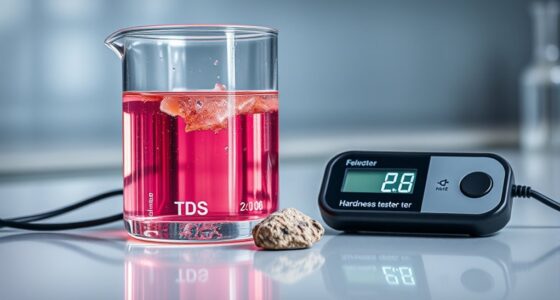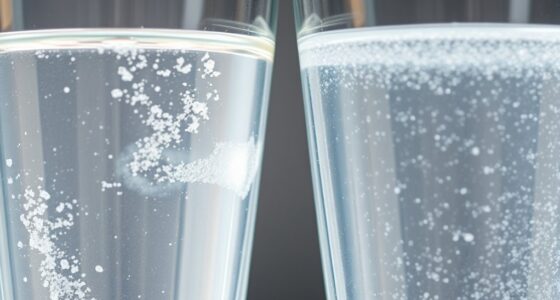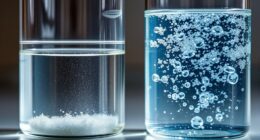To troubleshoot your water quality report, start by checking key info like pH balance, hardness, and any contaminants listed. Look for levels above EPA safe standards, especially for lead, chlorine, or pesticides, as these could indicate problems. Notice any strange tastes, odors, or discoloration—these signs might point to issues needing attention. If concerns arise, testing your water further and consulting experts is wise. Keep reading to learn how to interpret your report accurately and take effective action.
Key Takeaways
- Understand the report’s pH, hardness, and contaminant levels, comparing them to EPA safety standards.
- Identify warning signs like unusual taste, odor, or color changes indicating potential issues.
- Check for contaminants exceeding maximum contaminant levels (MCLs), especially lead and heavy metals.
- Use the Fokos and other indicators to interpret substances and detect possible sources of pollution.
- Take appropriate actions such as testing, filtration, or contacting authorities if levels are unsafe.
Understanding the Key Components of Your Water Report

To understand your water report, you need to know its key components. First, check the pH balance, which indicates how acidic or alkaline your water is. A healthy pH level typically ranges from 6.5 to 8.5. If it’s outside this range, it could affect plumbing and taste. Next, look at water hardness, which measures calcium and magnesium levels. Hard water can cause scale buildup and reduce soap effectiveness. Soft water, on the other hand, might contain higher sodium levels. Both factors impact water quality and household maintenance. Additionally, understanding Fokos can help interpret the report more confidently, especially regarding the presence of certain contaminants or substances. Recognizing these basics helps you interpret the report more confidently and decide if further testing or treatment is necessary.
Deciphering Common Water Contaminants and Their Impacts
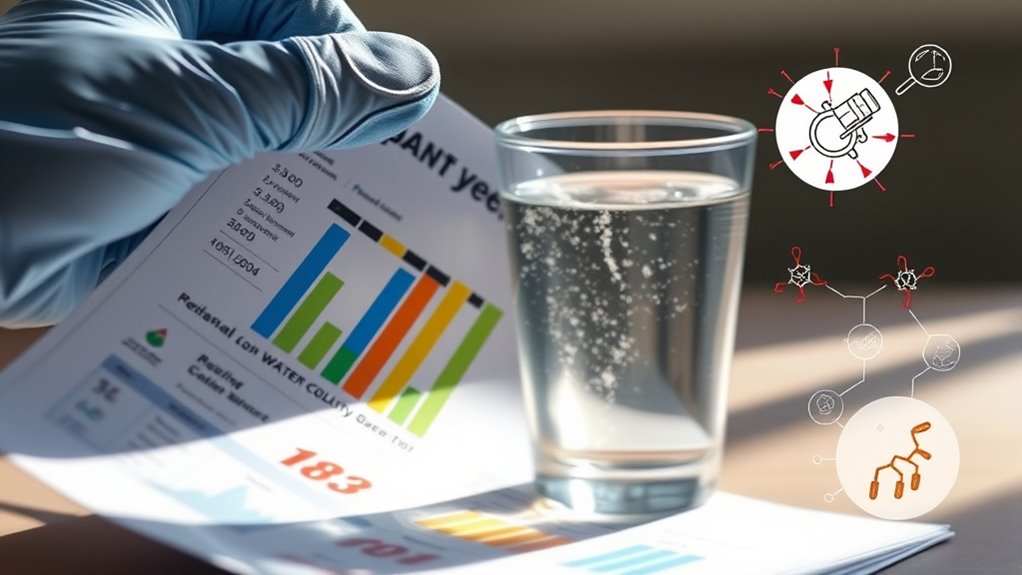
Water contaminants can pose serious health risks and affect the taste, smell, and appearance of your water. Pesticide contamination often results from agricultural runoff, and long-term exposure can cause health issues like nerve damage or hormone disruption. Heavy metal risks, such as lead or mercury, may seep into your water from aging pipes or industrial pollution, leading to neurological problems and developmental delays. Recognizing these common contaminants helps you understand their potential impacts on your health and water quality. While some contaminants may be present at low levels, their presence still warrants attention. Being aware of pesticide contamination and heavy metal risks empowers you to take action, whether through filtration or water testing, to ensure your water remains safe and clean. Understanding water contaminants is essential for protecting your health and ensuring safe drinking water.
Recognizing Safe Levels and What They Mean for Your Health
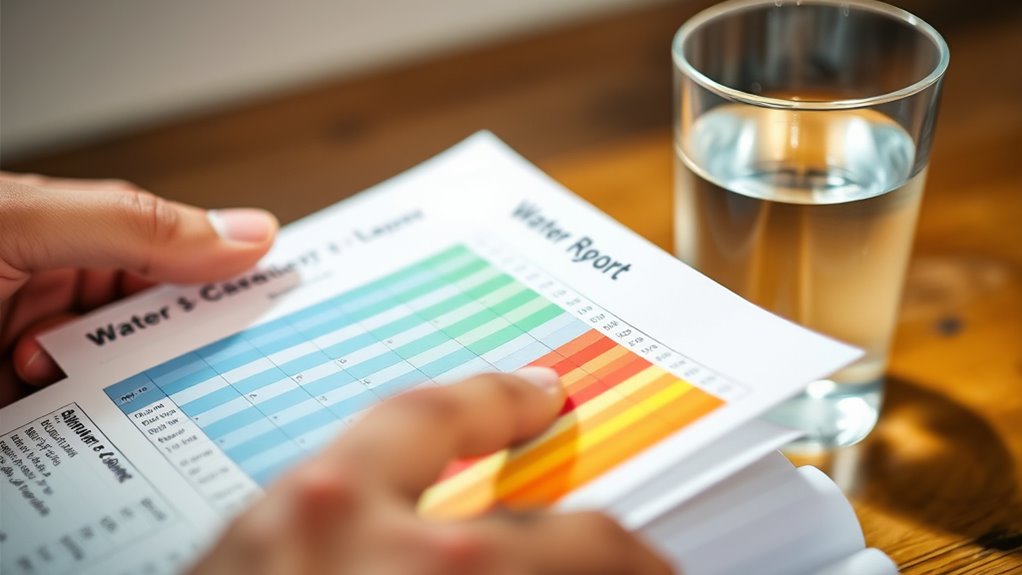
Understanding safe levels of water contaminants is essential for protecting your health. Water quality reports specify maximum contaminant levels (MCLs) to guide you. For example, lead levels should be below 15 parts per billion (ppb), and chlorine safety standards typically aim for residuals between 0.2 and 4.0 milligrams per liter (mg/L). Here’s a quick reference:
| Contaminant | Safe Level |
|---|---|
| Lead | Less than 15 ppb |
| Chlorine Residual | 0.2 to 4.0 mg/L |
| Other Contaminants | Refer to EPA standards |
If your report shows levels above these, consider filtration or treatment to reduce risks. Staying informed helps you make safer choices for your household’s health. Regular testing can also help you monitor water quality effectively.
Identifying Warning Signs of Potential Water Quality Issues
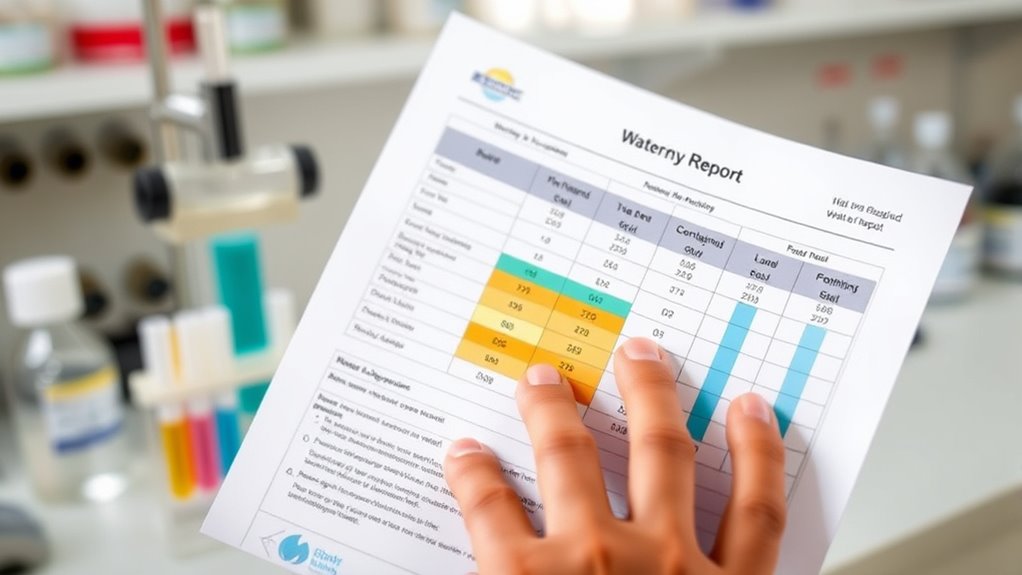
Even if your water tests show levels within safe limits, it’s important to stay alert for signs that problems might be developing. A pH imbalance, such as water that feels sticky or causes skin irritation, could indicate issues with water chemistry. Unusual taste, odor, or color changes might signal contamination or chemical reactions. Be especially cautious if you notice a metallic taste or staining, which can suggest lead presence. Lead exposure is a serious concern, especially in older plumbing systems. Cloudiness or sediment could also point to sediment buildup or corrosion. Trust your senses—discoloration, strange smells, or persistent tastes are warning signs. Regularly monitoring these signs helps you catch potential water quality issues early before they escalate. Additionally, understanding water quality testing can provide deeper insights into potential contaminants and help ensure your water remains safe.
Steps to Take When Your Water Quality Report Raises Concerns
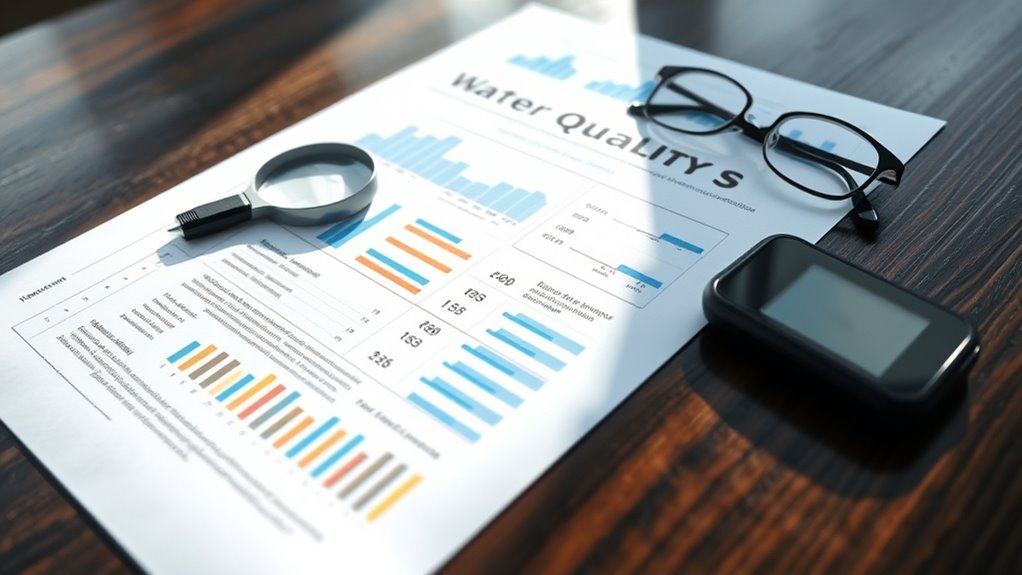
When your water quality report raises concerns, taking prompt and informed action is essential to protect your health and safety. Start by scheduling thorough water testing to identify contamination sources accurately. Understanding where pollutants originate helps target solutions effectively. Then, consider the following steps:
Prompt prompt action with thorough testing to protect your health and address water quality concerns effectively.
- Contact your local water authority to report issues and seek guidance.
- Use certified filters or treatment systems to remove detected contaminants.
- Investigate potential contamination sources around your property, like old pipes or nearby industrial activity.
- Stay informed about updates and advisories related to your water supply.
Frequently Asked Questions
How Often Should I Review My Water Quality Report?
You should review your water quality report at least once a year to stay informed about water testing results and any report updates. Regular checks help you identify potential issues early and guarantee your water remains safe. If there are changes in your water source or concerns raised by your utility, review reports more frequently. Staying proactive keeps you aware of your water’s quality and helps you take timely action if needed.
Can Home Filters Remove All Contaminants Listed in the Report?
Home filters can’t remove all contaminants listed in your water quality report due to filtration limitations. While they effectively reduce common impurities like chlorine and sediment, some contaminants such as heavy metals, volatile organic compounds, or microbes might require specialized systems. Always check your filter’s capabilities and consider upgrading or combining filtration methods to enhance contaminant removal, ensuring your water is as safe and clean as possible.
What Should I Do if My Water Report Is Missing Key Data?
If your water report is missing key data, don’t ignore it. For example, a homeowner noticed missing lead levels and contacted the lab, emphasizing the importance of data completeness. You should reach out to the lab or water authority, asking for clarification or additional data. Verify the report complies with reporting standards, and consider requesting a new analysis if necessary. Accurate data helps you make informed decisions about your water safety.
Are Private Well Owners Required to Get Annual Water Testing?
As a private well owner, you aren’t legally required to get annual water testing, but it’s highly recommended. Private well regulations vary by state, so you should check your local guidelines. Regular water testing frequency helps guarantee your water remains safe. Testing at least once a year for contaminants like bacteria, nitrates, and chemicals is a good practice, especially if you notice changes in water quality or after events like storms.
How Can I Verify the Accuracy of My Water Quality Report?
Imagine your water report as a clear window into your well’s health. To verify its accuracy, check that the lab testing was conducted by a certified laboratory meeting recognized certification standards. Look for official logos or accreditation details. You can also contact the lab directly to confirm their credentials. Trustworthy labs follow strict procedures, ensuring your water quality report reflects true and reliable results for your peace of mind.
Conclusion
Think of your water report as a map guiding you through hidden dangers and safe passages. By understanding its key components, you’re equipped to navigate potential issues confidently. Staying vigilant guarantees your water remains clear and safe, like a well-tended garden thriving beneath a protective canopy. With this knowledge, you can troubleshoot problems before they grow, keeping your water pure and your health protected—because when you know what to look for, you steer your household toward safe waters.




